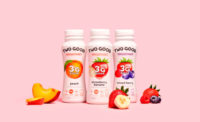
Editor's Note:A very low-calorie diet can help the heart age more slowly, according to researchers who recently released what they call the first-ever human study on the subject. The findings confirmed earlier studies on mice and rats that demonstrate the cardiac benefits of a restricted-calorie diet.
Such news stories, among others, have Americans seeking lower-calorie food and beverage options. One way to cut calories is to restrict sugar intake; thus, product developers are seeking out alternative sweeteners for lower-calorie formulations. This includes dairy foods formulators.
With that said, Dairy Foods talked with alternative sweetener suppliers. Here's what they had to say.

Photo coutesy of ARS USDA
Dairy Foods: Which dairy products are the best candidate(s) to be reformulated to have lower sugar contents, and why?
Opawumi:A regular premium ice cream contains about 17g of sugar per half-cup serving. We have been able to reduce this to about 4g per serving. The reduction can be even greater in regular low-fat yogurt, which typically contains about 42g of sugar per 8-oz serving. This number can be reduced to 10g using our maltitol solution.Dunning: Indeed, the potential for lower-sugar in ice creams is enormous. The industry already knows a great deal about sugar reduction in the development of no-sugar-added and low-carb ice creams. If it is possible to move from "ice cream" to "frozen dairy dessert," we can open the door on options to reduce sugars with the use of proteins, monosaccharides and minimal use of high-intensity sweeteners. This type of reformulation may make these products more attractive for parents to purchase for their children.
Klemaszewski: School lunch programs have been in the news lately because of the desire to reduce the sugar content in a number of products. Because of their prevalence in children's diets and school programs, the initial focus has been on sweetened dairy beverages such as chocolate milk. Dairy beverages are at a disadvantage as compared to other beverages in terms of sugar content because of the lactose naturally present in milk. Lactose has an equal caloric value to other sugars but has a lower sweetness level. Reduction of lactose in these products could be an alternative to reducing sugar content without decreasing sweetness. In addition to naturally occurring lactose, cultured and acidified dairy beverages have high titratable acidity levels, which requires a higher level of sweetener to be added compared to carbonated soft drinks, which have a lower buffering capacity. The total grams of sugar in an 8-oz yogurt smoothie often exceeds the sugar content of a carbonated beverage of the same serving size. Manufacturers are exploring reduced-sugar alternatives, which can include more intense sweeteners alone or in combination with fructose.
Dairy Foods: There are a range of alternative sweeteners available for use in dairy foods. What are some of them and how do they function with other ingredients?
Dunning:Polydextrose and sugar alcohols, such as lactitol, are sugar-free, reduced-calorie ingredients that can be used to replace the bulk and solids of traditional sweeteners in ice cream at usage levels from 2% to 10%. For a well-rounded sweetness profile, a blend of high-intensity sweeteners is often required. Aspartame/acesulfame potassium and sucralose/acesulfame potassium have been quite successful. Recently, Danisco has launched a line of flavor modulators designed to reduce the amount of high-intensity sweetener needed for a similar sweetness impact. This has a cost benefit, but is also attractive to consumers who try to limit their intake of high-intensity sweeteners.Riley: Sweetness enhancers, also called sugar extenders, can be used to replace the sugar flavor characteristics of carbohydrate-reduced products. These ingredients help such products maintain their full-bodied, original taste.
Ramsey: Brown rice syrup is a natural source of sweetness that masks any grain and germ notes. Its uniqueness as a light natural flavor allows it to stand alone, or it can enhance light to robust flavor profiles (i.e. fruit, spice, chocolate and nut flavors) making it ideal for use in dairy applications such as yogurts and desserts. Its usage level is similar to corn syrup and refined sugars; however, the method of manufacturing brown rice syrup is not as refined as corn syrup or sugar, leaving all of the nutrients in to aid in its functionality. Brown rice syrup is also a source of soluble solids so it can be used as a bulking agent, a source of protein and a natural shelflife extender. It contains complex carbohydrates for sustained energy and is hypoallergenic.
Klemaszewski: Polyols are available for sugar replacement in a range of dairy applications. Maltitol, for example, has a similar molecular weight and sweetness to sucrose. It is important to keep in mind that all polyols can cause discomfort if excessive amounts are consumed. Our research indicates that erythritol has the highest digestive tolerance and mannitol has the lowest.
Brooks: Using polydextrose and lactitol in reduced-sugar frozen desserts allows for calorie reduction, some sweetness contribution, body and texture development, and adequate freezing point depression.
Opawumi: SPI's maltitol is a liquid polyol that can be used to replace the bulk and functional characteristics of sucrose/corn syrup in dairy applications, as well as provide a natural, sweet-tasting profile. The product can be used as a sugar replacement in ice cream and milkshakes. In formulating a no-sugar-added ice cream, this product can be used at about 21% to 23% solids without any added high-intensity sweeteners. In a yogurt application, it can be used at levels of 8% to 10% by weight. Maltitol syrup can also be used in conjunction with high-intensity sweeteners.
Shazer: A very popular high-intensity sweetener among dairy food formulators is Splenda® sucralose. At 600 times the potency of sucrose, sucralose usage levels typically fall in the 0.008% to 0.015% range for flavored milks (lightly sweetened products) and the 0.015% to 0.02% range for ice cream products (heavily sweetened products). Synergies do exist between sucralose and other sweeteners including sugar, crystalline fructose and other high-potency sweeteners. The combination of sucralose and crystalline fructose in flavored milks has been successfully used to reduce added sugar by a third. Sucralose is an integral ingredient in many of our Rebalance™ Solution Sets, which are co-processed combinations of ingredients that allow food manufacturers to achieve certain nutritional goals, such as sugar, calorie or fat reduction in a product, without compromising on taste and texture.
Klemaszewski: Cargill recently introduced the SweetDesign™ family of ingredients for bakery products and frozen desserts. SweetDesign systems for ice cream include stabilizers and fat replacers in addition to alternative sweeteners. The reduction in fat and sugar allows for a further reduction in calories than replacing sugar alone.
Niness: Beneo™ brand inulin and oligofructose are soluble dietary fibers that cannot be broken down by the body but rather arrive in the colon intact, where they are fermented by beneficial bacteria. Because it is not digested by the body, Beneo does not cause an increase in blood sugar levels and is lower in calories than sugar. Additionally, recent studies have shown that Beneo actually reduces post-prandial glycemia (i.e. blood sugar levels after a meal), helping to reduce the insulin spike after eating. The ingredient most recommended for diabetic formulations is Beneo P95. This is a short-chain inulin that has almost identical functionality to sugar with one-third of the sweetness of sucrose. Beneo P95 also works well in combination with high-intensity sweeteners, helping to round-out the sweetness profile to taste more like sugar.

Photo courtesy of Treatt US Inc.
Dairy Foods: Please describe any formulation or process modifications that are necessary when using select alternative sweeteners, as well as any usage limitations.
Klemaszewski:Yogurt culturing can take additional time if high levels of erythritol are present. This is due to a higher osmotic pressure.Shazer: The stability of sucralose allows it to be incorporated into all dairy products prior to pasteurization. It remains stable throughout heat processing, culturing and shelflife with no loss of sweetness or deterioration of flavor profile. When replacing sugar in many formulas, the physical and chemical properties of sugar must be replaced. Polydextrose, in combination with sugar alcohols, can replace sugar's functional properties such as freezing point depression, ice crystal control and humectancy.
Opawami: Like fiber, polyols are low-digestive carbohydrates and when consumed in excess can lead to some digestive discomfort. This can usually be avoided by simply controlling the amount of polyols used per serving. Generally we recommend limiting the product use at 15g to 20g per serving size in the finished food product. From a processing standpoint, Maltisweet™ IC maltitol is formulated to directly replace sucrose/corn syrup with no processing modifications. Sweetness can be increased, if desired, through addition of high-intensity sweeteners.
Dunning: No-sugar-added ice creams can still contain quite a bit of sugar due to the presence of lactose. There are a few options to consider for additional sugar reduction in ice cream. Developers can reformulate the base mix to contain fructose or other monosaccharides to reduce the freezing point. Polydextrose can be used to build back the solids for mouthfeel. The lactose contribution of the sugars can also be reduced by the use of milk/whey protein isolates and concentrates. However, using these ingredients may move the formulation away from the standard of identity of the ice cream or other product.
Dairy Foods: What does your crystal ball say for the future regarding the use of alternative sweeteners and lower-calorie formulations?
Ramsey:Recent trends indicate that consumers want good-for-you foods but are not willing to sacrifice taste. They are also becoming more savvy and reading ingredient declarations and are more particular about the foods they purchase. Select specialty/alternative sweeteners fit both these criteria in ingredient formulations.Klemaszewski: The number of ingredients available to add sweetness has grown in the past 20 years. Development in this area will continue; however, regulatory approvals will dictate the speed of product introductions. There is still no single ingredient to replace sugar as evidenced by the range of sugar-free soft drinks, which few would say are a match for their full-sugar counterparts.
Moreau: Heightened media and government attention around consumer health issues such as obesity and diabetes has prompted formulators across various food categories to look to alternative sweeteners as a means of offering consumers healthier versions of their favorite foods. Consumers are becoming more and more educated about health and nutrition and are paying much closer attention to nutrition labels than ever before. Foods that can offer reduced-sugar, calories, fat, etc., while still meeting consumer expectations for taste, will continue to win in the marketplace during the next several years.
Ferre: With the current obesity epidemic-especially child obesity-usage of alternative sweeteners and launch of low-calorie products will continue to grow. Alternative sweeteners that deliver the best taste and offer the widest set of product applications will lead the trend.
Brooks: Currently, some parents seem hesitant to give their children foods containing high-intensity sweeteners. However, with the rise in childhood obesity and increased awareness of the higher sugar intake of children, parents may be more open to their children consuming reduced-sugar foods. We don't foresee a significant change over to no-sugar-added and sugar-free products for children, but certainly a move towards reduced-sugar products. With this change, parents will most likely be more accepting of some high-intensity sweeteners in their children's diets.
Ferre: Our own consumer research indicates that parents' acceptance of certain alternative sweeteners for their kids is increasing, especially in reference to sucralose.
Klemaszewski: Per capita consumption of sugar has recently started to decline after a long-term climb indicating alternatives to sugar are being accepted. Increasing concerns about childhood obesity has already produced cereals sweetened with sugar substitutes and will continue to drive acceptance of alternative sweeteners in beverages and other products targeted at kids.
Moreau: Parents have traditionally been sensitive about the use of alternative sweeteners in kids' products; however, as sweetener technology continues to improve and consumers become more educated about various sweetening ingredients, acceptance seems to be growing.
Ramsey: With the increase in childhood obesity and diabetes, parents have taken a closer look at the ingredients that go into foods that their family eats. The new food pyramid has helped in educating parents to the caloric value of foods (complex vs. empty calories), in addition to educating them on the need for a balanced diet.
Suppliers surveyed:
Kevin Riley, technical director, MastertasteDonna Brooks, product manager, Danisco Sweeteners
Linda Dunning, group manager/frozen desserts and beverages, Danisco USA
Jordi Ferre, vice president of sales and marketing, sucralose, Tate & Lyle
Joe Klemaszewski, dairy applications specialist, Cargill Inc.
Kathy Moreau, marketing director, SPI Polyols Inc.
Kathy Niness, v.p. of marketing and sales, Orafti Active Food Ingredients
Clement Opawumi, senior applications scientist, SPI Polyols Inc.
Kevin Ramsey, director of sweeteners, Chr. Hansen Inc.
William Shazer, director of laboratories, Tate & Lyle

